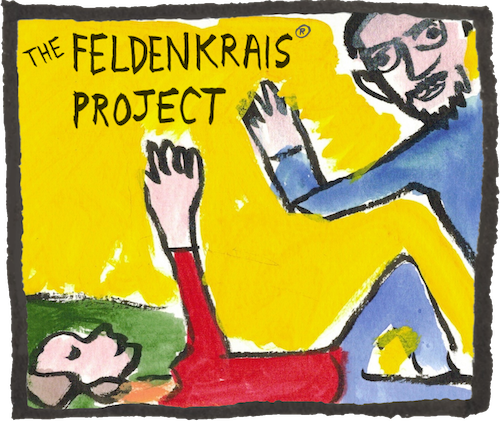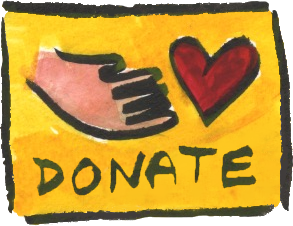What Is Good Posture? (Patrons)
Standing, chair-seated, and transitioning between. Experience for yourself Moshe Feldenkrais's three-part answer to his lesson title: 1) Good posture is synonymous with the greatest potential for action. 2) Whether we're standing, sitting, or anywhere in between, in good posture our bones (not our muscles) must continuously counteract gravity, leaving our musculature free for action. 3) Posture improves spontaneously when we eliminate superfluous efforts in the sit-stand-sit transition, as we become more sensitive to the physics and neurology of that function. A 5-minute talk begins the recording. Demonstrations and principles are in the Clarifications and Curiosities tabs.
Before you begin read this for practical tips and your responsibilities, and check out Comfort & Configuration below.
Recorded live in a Feldenkrais Awareness Through Movement (ATM) class, this lesson is copyright Nick Strauss-Klein, for personal use only.
Tip – Complete the Movement
Study tip: Complete one movement before beginning the next. You’ll improve faster if there’s enough time between movements that you feel fully at rest.
Tip – Pause the recording
Study tip: If you’re really enjoying a movement and want to explore longer, or you just need a break for a while, pause the recording!
Tip 3 – Head Support
Study tip: It helps to have a large bath towel nearby when you start a lesson. You can fold it differently for comfortable head support in any configuration.
Tip – What’s New
Community tip: See what Nick and other Felden-fans are interested in right now. Check out What’s New at the bottom of our homepage for recent blog posts and listener comments.
Tip – what to wear
Study tip: Wear loose, comfortable clothes that are warm enough for quiet movement. Remove or avoid anything restrictive like belts or glasses.
Tip 2 – Social Sharing
Project tip: Try the social buttons below. Please help us to achieve our vision: spreading the life-changing benefits of Feldenkrais study as widely as possible!
Tip 1 – Interrupted?
Study tip: Interrupted or don’t have enough time? You can return to the lesson later today or tomorrow. Read how best to continue your learning on our FAQ page.
Tip – Join!
Join the Project! Members and Patrons see streamlined lesson pages, and can access My Journey (the and above), and the Related Lessons tab below.
Tip – Comments
Project tip: Leave a lesson comment below! It’s a great way to give feedback or ask a question, and it helps google find us so we can achieve The Feldenkrais Project’s vision!
Tip – Technical Difficulties
Tech tip: If you have any trouble with the audio player, reboot your browser. That solves most issues. If not, please contact Nick.
Tip – Lesson names
What’s in a lesson title? Lessons are about an hour unless a shorter duration is shown in the title. Thanks to our donors they’re freely offered unless marked “Patrons” – those are how we thank our Patron-level donors.
Tip – Directions are Relative
Study tip: Directions are always relative to your body. For example, if you’re lying on your back “up” is toward your head, and “forward” is toward the ceiling.
Tip 5 – Discomfort
Study tip: If a configuration or movement causes any increase in discomfort, or you feel you just don’t want to do it, don’t! Make it smaller and slower, adapt it, or rest and imagine.
Browser/device size and audio player
Tech tip: On mobile or tablet? Once you start playing the audio, your device’s native playback controls should work well.
Tip – skip a lesson
Study tip: If you can’t find a comfortable way to do the initial movements or configuration of a lesson, it’s ok to skip it for now and go on to another lesson.
Tip – Rewinding
Study tip: Many instructions are repeated. If you get a little lost, rest and listen. You’ll often find your way. Or use the rewind button on the page or your mobile device.
Tip – LESSS is more
LESSS is more: Light, Easy, Small, Slow, & Smooth movements will ease pains and improve your underlying neuromuscular habits faster than any other kind of movement, no matter who you are or what your training is!
We offer over 50 free lessons, but this one's just for our Patron-level donors. You can learn about it in the free lesson notes and comments below, but to access the audio you’ll need to join The FP as a Patron. Learn more
- Comfort & Configuration
- Clarifications
- Curiosities
- Context
- Related Lessons
- Source
You won’t need a mat, but you’ll need two chairs. You’ll sit on one, which can be a chair or stool, for much of the lesson. It should be level, non-rolling, and tall enough that your hip are at least a little higher than your knees.
It should also be firm enough to feel your sitbones clearly when seated upright at the front edge of the chair. If the surface feels too hard you may want to put a layer or two of bath towel on it.
Often a simple kitchen or dining room chair works, perhaps with a large book on top of it if you need the height.
Chair #2 only needs to be non-rolling and have a chair back that you can rest your hands or arms on.
If you find the sit-to-stand practice later in the lesson difficult:
- Sit on a taller chair. Later you can try it with progressively lower chairs.
- Try having your feet a little closer to you in seated than is described: rather than your heels under your knees, you might have the front of your feet under your knees.
- See the Related Lessons tab for preparatory study, then return to this lesson.
Usually in Feldenkrais, when we tip the pelvis side to side in seated we invite the spine to sidebend to counter it. And usually, when we roll the pelvis forward and backward, we invite the spine to arch and round.
This lesson is different: we’re asked not to arch, not to round, and not to sidebend the spine. Rather the spine, head, and pelvis all stay aligned as we tip on our sitbones in most of the seated and sit-to-stand movements.
After you do the lesson the first time:
#1 Watch the class discussion from after this audio recorded, which includes a video demonstration from a student with commentary from Nick. She finds her way through several common confusions which are helpful to see. Eventually the movements become very clear.
Logged in Patrons can link to this clip from Patrons Quarterly Conference Zoom event right here:
#2 Watch the following amazing videos by Feldenkrais Practitioner Andrew Gibbons as you continue to practice this learning. They are not full teachings of the lesson, but rather reference videos to help you understand and embody this learning.
- What Is Good Posture? – Great explanations, plus constant video examples so you can see these ideas at work.
- A Look Inside the IOPS Sit-to-Stand Curriculum – See Moshe Feldenkrais demonstrate these concepts with a one-to-one student! Watch Feldenkrais Trainer Jeff Haller teach these concepts in a workshop.
- What Is Good Posture? Part 2 – Andrew’s addendum, plus additional visual examples.
Moshe Feldenkrais made this lesson #1 in the book he wrote to introduce his method to the masses, but it isn’t taught often in public classes. His writing is difficult to parse, and the movements themselves are at first difficult for most people to do and understand.
On the surface, Moshe’s titular question, and this lesson’s means of answering it, don’t seem to line up. Though it begins by exploring the length and uprightness of standing and sitting, why is it that Moshe spends the whole second half of the lesson exploring the transition back and forth between chair-seated and standing, in a lesson he calls “What Is Good Posture?”
In short, the sit-stand-sit transition affords us opportunities to reduce superfluous efforts and make sensory distinctions about the details of a healthier, more dynamic posture. Posture should never be thought of as static since we’re always moving (even breathing counts, since it disturbs our center of gravity), and our potential to move freely and easily in any direction without hesitation is a biological imperative.
By becoming far more sensitive and efficient in the dynamic transition between sitting and standing, we can learn to sense and shed the habits we’ve accrued that interfere with a more natural way of supporting ourselves while upright.
The details
In his long introduction and several discussions throughout, Feldenkrais expounds on the principles at work in the lesson. I summarized many of them in the audio recording. Here are those principles, and more. The full chapter is worth a read for even more information.
- What is good posture? “Good upright posture is that from which a minimum muscular effort will move the body with equal ease in any desired direction.” Notice that Moshe’s definition isn’t a description of a position. Instead it focuses on efficiency and potential for movement.
- We may have been told to stand “straight,” but consciously trying to achieve that can’t be maintained without continuous mental and physical effort. Anything necessary, urgent, or interesting will distract us.
- What’s more, “straight” isn’t even precise, since even in an ideal state almost none of our bones align vertically with gravity. And some folks’ structures will never allow them to stand very “straight,” due to injuries or how they were born. Yet they can learn to functional as well in gravity as anyone else, with efficiency, grace, and power.
- So, “Any posture is acceptable as long as it does not conflict with the law of nature, which is that the skeletal structure should counteract the pull of gravity, leaving the muscles free for movement.”
- It follows that poor posture is when muscles do job of the skeleton, holding us up against gravity. In that state they’re wasting energy, preoccupied, and unavailable to do what they’re meant for: moving our bodies!
- Much of our standing is organized by an older, lower level of our nervous system than our voluntary musculature. But unlike the animals who stand entirely like that, relying on instinct to stand (the experience of their species), we are a lot more adaptable. We rely more on the experience of the individual, thus we learn to stand in a unique way. Often we accumulate inefficient habits.
- We are learning to sense and reduce superfluous efforts so we can rely more on the ancient wisdom of the lower parts of our nervous system in sitting, standing, and transitioning between the two. When we’re well-organized and our center of gravity is over our base of support, then the reflex to straighten our legs (from the lower levels of our nervous system) takes over, simply and efficiently.
- But if we have poor posture, if we’re resisting gravity with our muscles instead of our bones, the natural reflex to simply unfold ourselves into standing is muted. This is true whether we’ve accumulated unnoticed habits of excess effort, or we’re trying hard with voluntary muscles. (So don’t try hard in this lesson!)
- “Anything that tends to lessen the sensitivity of the power of discrimination will slow down response to stimuli.” In other words, if we can’t sense the availability of the standing reflex when it is stimulated, we’ll override it with volition or habit, both of which are less efficient.
- Whenever we sense fewer details, we only make corrections when the need is “more urgent and requires more muscular effort.” We don’t notice slight changes. Our movements become coarser. We try harder, and override the most natural way of moving in all sorts of activities.
- So our goal in this lesson is to reduce superfluous effort and thus increase our sensitivity.
- How did our movements become coarse? What diminishes our sensitivity? Physical or emotional pain is “one of the original causes.” “Pain that undermines confidence in the body and self is the main cause of deviations from the ideal posture. Pain of this kind reduces the individual’s value in his own eyes.”
- In my words, pain shrinks our self-image, diminishing the range of our thoughts, feelings, movements, and sensitivity to stimuli. In this state “nervous tension rises,” reducing sensitivity even more, so we don’t notice even large deviations from ideal positions, and we must do more and more postural work with muscles. In this way “Control may become so much distorted that while we think we are doing nothing we are in fact straining muscles needlessly.”
This lesson is #1 of 12 in Moshe Feldenkrais’s 1972 book Awareness Through Movement. The Feldenkrais Project has a collection of lessons from this source.
It also appears as the final lesson in our Grounding for Liftoff course.
It was recorded during our Patrons Quarterly video call of August, 2023, but we highly recommend studying from the audio version above since it’s been edited for better clarity, flow, and sound quality.
While taught in my own words, this lesson comes directly from Moshe Feldenkrais’s 1972 book Awareness Through Movement. Logged in donors will see more information on sources I used and changes I made here:
Members and Patrons. Learn more or login:
Got a question for Nick, or a thought about this lesson?
Use the comments section below! Public comments build our community and help search engines find us.

3 Comments
Leave a Comment Cancel Reply

These icons are part of "My Journey," where you can make lists of your own saved and favorite lessons, courses, and talks.
To access this donor benefit login below or Join the Project
Click here if you need to reset your password


A while back, as I was considering which ATM book lesson to record next, I received this email from a listener about this lesson, as it appears in Feldenkrais’s book.
I find it inspiring – maybe you will too! I’m sharing it with Ann’s permission:
I’ve just experienced this special ‘Feldenkrais moment’ – finding a wonderful sensation out of the tiniest movement.
It’s hot and humid outside and I’m standing at my window looking at a group of beautiful trees, letting thoughts come and go while swinging gently back and forth. And there is your question that caught my attention when I did ‘What is Good Posture’ yesterday:
‘Do your shoulders change as you move front and back, the collarbones ……. your ribs?’
So I listen closely to these parts of my body and feel the sensation of my bones reorganizing themselves nicely, the same with my right wrist, my thighs, my lower legs and the soft gliding in my ankles.
Afterwards I’m perfectly balanced and I love the feeling of my toes touching the ground.
This lesson is precious feldenkrais gold! I wish that teachers would work more on developing vertical lessons — they can convey something important, not better than the horizontal ones, but valuable for those who want to progress. Thank you for taking it on for us.